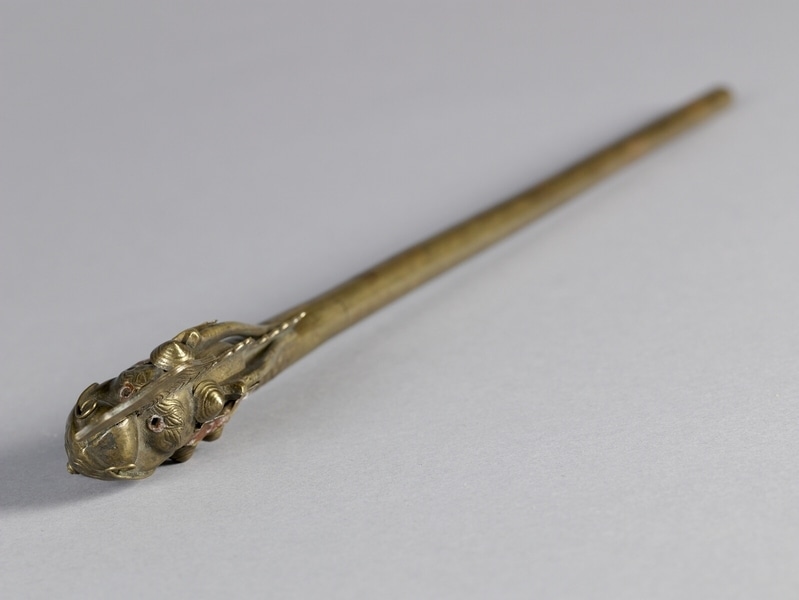Hair Pin Item Number: Ed1.280 from the MOA: University of British Columbia


Description
A very long cylindrical hairpin made of brass with a dragon head at one end. Long cylinder tapers to a point at the end opposite the dragon head. Head is much larger than the diameter of the pin and has many added details such as scales behind the head, a forward-facing flat flame-like projection on top of the head, moulded eyes, a nose, a mouth, added whiskers, a small beard, and long trailing ear-like strands. Mouth, and side panels are inlaid with red enamel, and there is an empty round hole at the front of the mouth.
History Of Use
Such hairpins were worn by women of the official “Yangban” class for formal wear. Pins of this shape, size, and material and with a dragon image were for very high-class women. High-class women might also use hairpins made of gold, silver, jade, and red jade, and with images of birds, lotus, peony, pomegranate, or chrysanthemum. Brides also could wear such hairpins. Ordinary women used hairpins made of bamboo, wood, bone, or horn. Women’s long hair was wound around it at the nape of the neck, and was partially covered with a ribbon. The hair style, in which the hair was braided and wrapped around the hairpin, was called “Jjok-mo-ri”. Hairpins were made of many different materials and with many different motifs, and were named accordingly. Small ornamental hairpins were also added. In the early and middle Chosun Dynasty women just had “black cloud” wigs and did not wear hairpins and ribbons.
Item History
- Made in Korea during 1890
- Owned by Wilhelm Helmer before February 17, 1984
- Received from Wilhelm Helmer (Seller) and Museum of Anthropology Donations Fund (Funding source) on February 17, 1984
What
Who
- Culture
- Korean
- Previous Owner
- Wilhelm Helmer
- Received from
- Wilhelm Helmer (Seller) and Museum of Anthropology Donations Fund (Funding source)
Where
- Holding Institution
- MOA: University of British Columbia
- Made in
- Korea
When
- Creation Date
- during 1890
- Ownership Date
- before February 17, 1984
- Acquisition Date
- on February 17, 1984
Other
- Item Classes
- metalwork
- Condition
- fair
- Current Location
- Case 77
- Accession Number
- 0958/0001